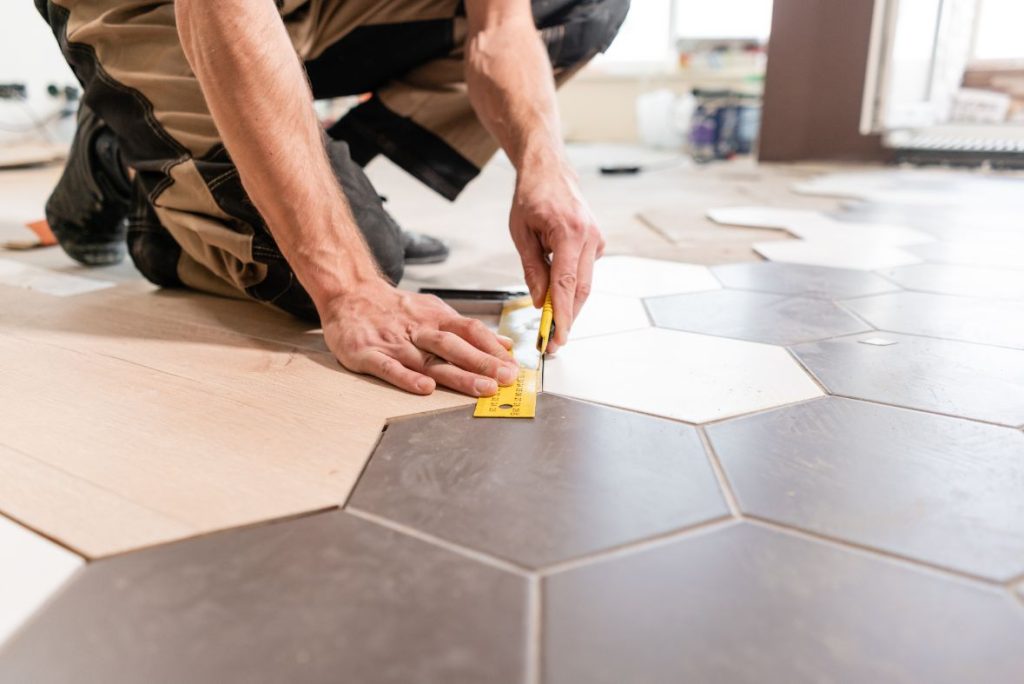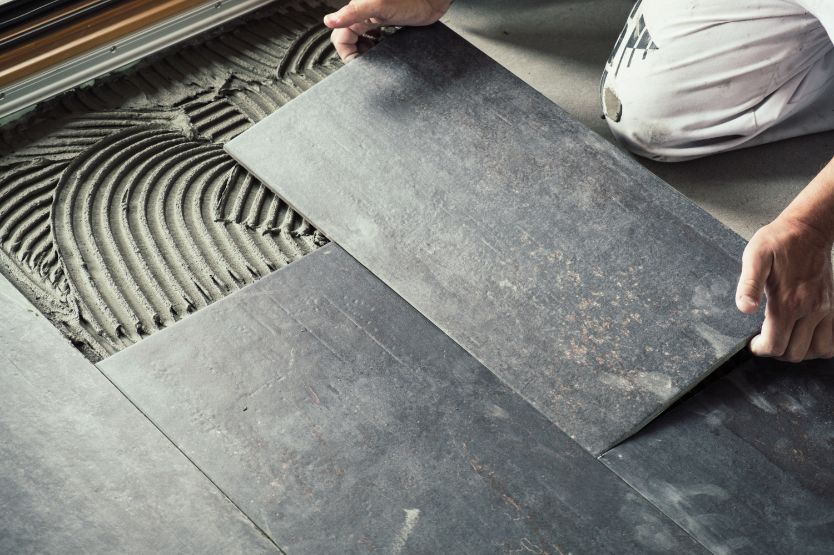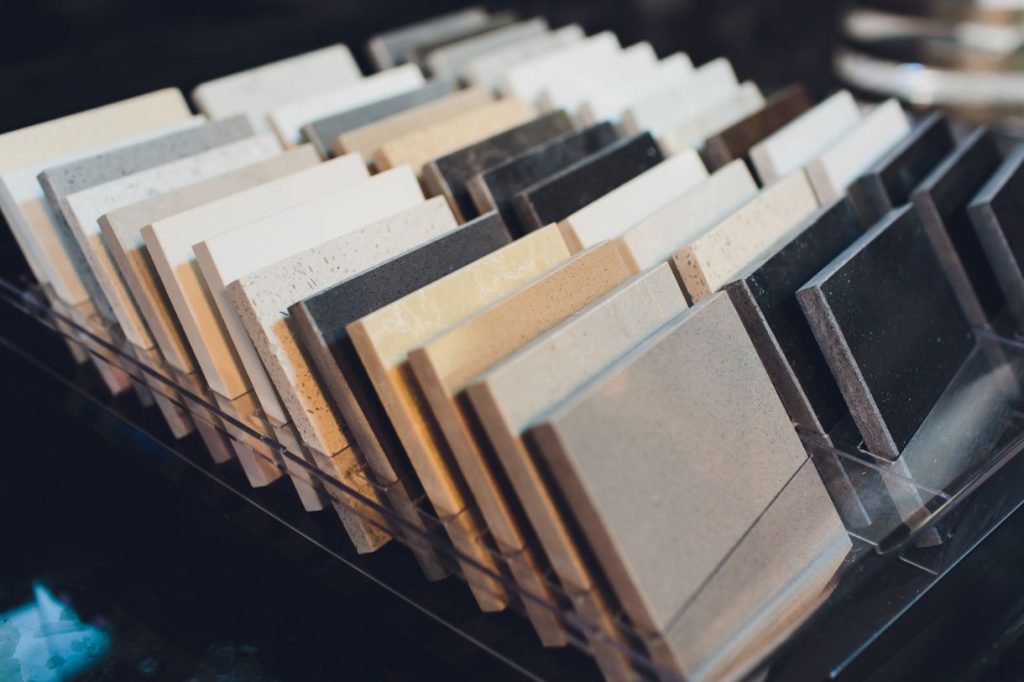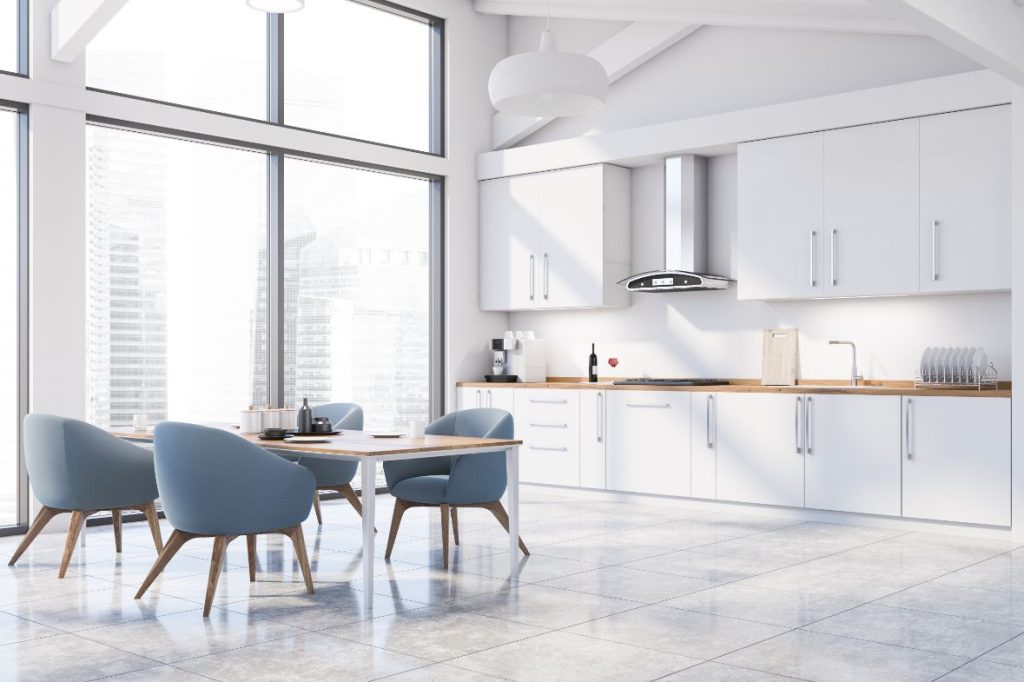Ceramic has long been synonymous with kitchens and bathrooms.
Ceramic has long been a must for water features. Moisture-resistant, elegant and easy to clean, it combines aesthetics and functionality in the most heavily used areas of the home.
On this page, you’ll discover why ceramic is such a popular choice for kitchens and bathrooms in QuebecIn this section, you’ll discover why ceramic is such a popular choice for kitchens and bathrooms in Quebec, which types to choose, current trends, average prices and how to get quick quotes for professional installation.

Table of contents
Why choose ceramics for the kitchen and bathroom?
Ceramic tiles for kitchen and bathroom floors are robust, durable and hygienic. It offers superior protection against water and humidity, while harmonizing with a multitude of decorating styles.
So here’s why you should opt for ceramic flooring!
Ceramic is a waterproof coating
Ceramic is completely resistant to water and humidity, without suffering any damage. It's watertight enough to protect the floor structure behind it, which is why it's the ideal option for kitchens and bathrooms.
A ceramic floor is easy to clean
Ceramic is completely resistant to water and humidity, without suffering any damage. The top of a ceramic floor is smooth and shiny, making it easy to clean. As the kitchen and bathroom are two rooms where damage can occur, this is an asset not to be overlooked!
Ceramic flooring is a durable choice
Unlike wood, floating floors and vinyl, ceramic will take decades to show signs of wear. It's likely to be changed because of changing trends, not because of obsolescence. And there's nothing we can do about the passing fashions.
Ceramic tiles can also be used for shower walls
Ceramic showers are all the rage these days. And one of the advantages of a ceramic bathroom floor is that you can cover the shower walls with ceramic tiles that match, or are identical to, those on the floor.
How much will a ceramic floor cost in 2025?
Ceramic is one of the most expensive flooring materials.
Installation requires preparation of the floor, installation of support panels, application of mortar and a finishing grout. This is not the case with low-cost floating floors, to say the least.

The cost of a ceramic floor varies according to the range chosen, the surface to be covered and the complexity of the installation. Here’s an overview of prices for materials and labor.
Ceramic flooring | Average price |
Economical ceramic flooring | Starting at $2.50 / ft2 |
Ceramic flooring – mid-range | 4 to $5 / ft2 |
Ceramic flooring – high-end | 7 and more / ft2 |
Porcelain tile flooring | 4 to $5 / ft2 |
Natural stone flooring | 6 to $11 / ft2 |
Installation labor With a professional tiler | 6 to $12 / ft2 |
What’s the difference between economy and premium ceramics?
Composition has a lot to do with it, as quality ceramics will offer better durability than lower-end options.
However, the level of detail in the ceramic, the type of finish, the color and, of course, the trends of the day, all have an upward impact on the cost of ceramic. And this is what differentiates ceramic ranges.
So, what elements increase the cost of your ceramic floor?
- Ceramic quality
- Tiler hourly rate
- Area to be covered
- The installation method
- Showering at the same time
How can you save on the cost of your ceramic floor?
By comparing countless ceramic tile models in stores, and comparing a minimum of 3 contractor quotes for installation. Soumissions Plancher can help you with this second step!
What are the most common types of ceramic used in kitchens and bathrooms?
Not all ceramics are created equal. Here’s an overview of the most popular materials for their performance and style.
Ceramic tiles in natural stone
This type of ceramic can be composed of a variety of natural stones, and some can even have an imitation marble, Terrazzo or slate look. There’s no shortage of looks!
Porcelain ceramics
Porcelain tile flooring is the most water- and impact-resistant option. For a kitchen floor where splashes and dropped utensils are commonplace, this is an option to consider.
Fired clay ceramics
Finally, fired-clay ceramic is a frequently used option, but its lifespan is greatly affected by thickness and manufacturer.

What are the ceramic trends for the kitchen and bathroom in 2025?
Current trends favor bold formats, realistic imitations and original poses. Here’s what stands out this year:
If so, check out our Top 5 Ceramic Flooring Trends 2025!
Large CERAMIC tiles
The days of tiny ceramic tiles are well and truly over. In fact, we've gone completely the other way, with 24''X24'' ceramic tiles now all the rage. Whether for a bathroom floor, a kitchen or a complete shower, large ceramic tiles give a minimalist, uncluttered look.
Imitation CONCRETE" ceramics
Concrete floors are becoming increasingly popular in the residential sector. The problem? A waxed or epoxy-treated concrete floor costs a small fortune. Imitation concrete" ceramics therefore offer a solid alternative for achieving the look of a concrete floor, but at an affordable price. And the results are convincing.
Ceramic tiles laid in CHEVRON
Herringbone tile laying involves laying rectangular tiles diagonally, or at an angle. It gives a singular, sought-after look, but it has to be said that installation is slightly more complicated. Herringbone can also be used in the shower, on the bath and even on bathroom walls.
Imitation WOOD" ceramics
It's not just concrete that can be imitated with ceramics. Ceramic planks that imitate wood are also very popular in 2025. In fact, their main advantage is that they convincingly imitate wood, while offering greater durability and water resistance. What's more, ceramic is compatible with underfloor heating, which is not the case with wood floors.
TERRAZZO-style ceramics
Terrazzo is making a comeback after many years in the dustbin. Except that instead of being used to cover school floors, it's being installed in bathrooms and kitchens. Indeed, that's why Terrazzo effect ceramics are so popular and in demand these days.
What are the advantages and disadvantages of ceramic flooring?
Ceramic is a floor covering that’s hard to beat in many ways, but that doesn’t mean it’s a perfect solution.
That’s why Soumissions Plancher has decided to lend a hand by comparing the pros and cons!

Benefits
- Premium floor look
- Perfectly water-resistant
- Extreme durability
- Ideal for underfloor heating!
Disadvantages
- Dependent on purchase
- Specialized installation by a tiler
- Susceptible to breakage
- Rigid floor covering (less comfortable)
How do I install a ceramic floor?
The key to quality installation is good preparation. Here are the steps followed by professional tilers:
- 1. Prepare rooms (kitchen and bathroom)
- 2. Preparing the floor surface
- 3. Mixing mortar/ceramic glue
- 4. Installation of support panels
- 5. Drawing reference lines
- 6. Preparing tile laying and positioning
- 7. Apply mortar and check consistency
- 8. Laying ceramic tiles (and levelling)
- 9. Applying ceramic grout
- 10. Cleaning and polishing the ceramic floor
How to choose the right ceramic tiles for your shower?
Avoid ceramics that are too porous
Porous ceramics are prone to staining, and with the use of soap, shampoo and other hygiene products, permanent stains can form.
Not to mention the fact that maintenance will also be more demanding, so it’s best to opt for a more opaque ceramic finish.
Choose a style that matches the floor’s ceramic tiles
Make sure the color, finish and shape of the ceramic tiles in the shower match those on the floor. Tiles aren’t redone every day, so pay attention to detail!
Watch out for slippery ceramics!
Ceramic tile style is certainly important, but you’ll probably find that it’s of secondary importance if your shower tiles are slippery. A shower floor needs a minimum of grip!
Why use a tiler for your ceramic project?
The tiler is a specialized craftsman who masters all the technical aspects of installation. Thanks to him :
- Clean cuts
- Uniform joints
- Flat, flawless surface
- The project meets sustainability standards
How to choose the best tiler for your project? Put your trust in Soumissions Plancher. With just a few clicks, we’ll refer you to ceramic tile contractors in your area.
|
|
How to choose the best tiler for your project? Put your trust in Soumissions Plancher. With just a few clicks, we’ll refer you to ceramic tile contractors in your area.
Compare 3 quotes for your ceramic floor
Want to know the true cost of your project? With Soumissions Plancher, get up to 3 estimates from specialized contractors near you.
By filling in our form, you will receive :
– Competitive prices
– Personalized advice
– Guaranteed, compliant installation
It’s quick, easy and without obligation.




